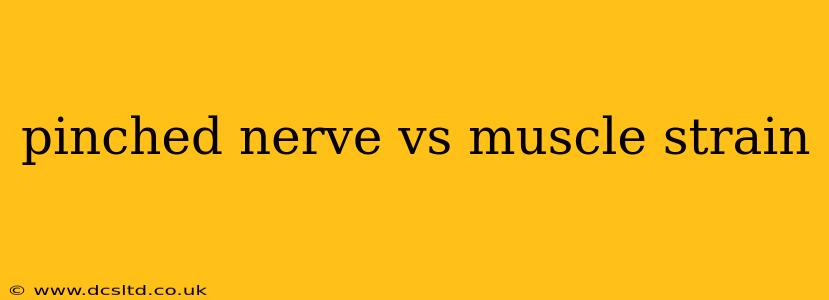Experiencing pain in your neck, back, or limbs can be incredibly frustrating. Two common culprits are pinched nerves and muscle strains. While both can cause significant discomfort and limit your mobility, understanding the key differences is crucial for proper diagnosis and treatment. This guide will delve into the distinctions between a pinched nerve and a muscle strain, helping you better understand your symptoms and seek appropriate care.
What is a Pinched Nerve?
A pinched nerve, also known as a compressed nerve, occurs when surrounding tissues—bones, cartilage, tendons, or muscles—put pressure on a nerve. This pressure interferes with the nerve's ability to send signals, leading to a variety of symptoms depending on the location of the pinched nerve. Think of it like squeezing a garden hose – the flow of water (nerve signals) is restricted.
Common causes of pinched nerves include:
- Herniated discs: A bulging or ruptured disc in the spine can press on nearby nerves.
- Spinal stenosis: Narrowing of the spinal canal puts pressure on the spinal cord and nerves.
- Bone spurs: Overgrowths of bone can impinge on nerves.
- Repetitive movements: Repeated actions, like typing or lifting heavy objects, can irritate and compress nerves.
- Injury: A direct trauma to the neck or back can cause nerve compression.
Symptoms of a pinched nerve can vary widely but often include:
- Sharp, shooting pain: This is a hallmark of a pinched nerve, often radiating down the affected limb.
- Numbness or tingling: A loss of sensation in the area supplied by the compressed nerve.
- Weakness or muscle atrophy: Decreased strength or muscle wasting in the affected area.
- Burning or electrical sensations: A characteristic feeling of pins and needles or shocks.
What is a Muscle Strain?
A muscle strain, also called a pulled muscle, is an injury to a muscle or tendon (the tissue that connects muscle to bone). Strains range in severity from mild (a simple stretch) to severe (a complete tear). They typically result from overuse, sudden forceful movements, or inadequate stretching.
Common causes of muscle strains include:
- Overexertion: Pushing muscles beyond their limits during exercise or strenuous activity.
- Poor posture: Maintaining poor posture weakens muscles and makes them more susceptible to injury.
- Sudden movements: Twisting or lifting incorrectly can easily strain muscles.
- Lack of flexibility: Insufficient stretching before exercise or activity increases the risk of strains.
Symptoms of a muscle strain often include:
- Muscle pain: This is usually localized to the affected muscle and can range from mild to severe.
- Muscle spasms: Involuntary muscle contractions that can cause stiffness and pain.
- Swelling: Inflammation and fluid buildup around the injured muscle.
- Bruising: Discoloration of the skin due to broken blood vessels.
- Limited range of motion: Difficulty moving the affected muscle or joint.
How to Tell the Difference: Pinched Nerve vs. Muscle Strain
Distinguishing between a pinched nerve and a muscle strain can be challenging, as some symptoms overlap. However, here are some key differences:
- Type of pain: Pinched nerve pain is often sharp, shooting, or burning, while muscle strain pain is typically a dull ache or cramp.
- Radiation of pain: Pinched nerve pain often radiates down a limb, following the path of the nerve. Muscle strain pain is usually localized to the affected muscle.
- Numbness and tingling: Numbness and tingling are more characteristic of a pinched nerve.
- Weakness: Significant muscle weakness is more common with a pinched nerve.
Can a Muscle Strain Cause a Pinched Nerve?
Yes, it's possible. Severe muscle spasms or inflammation from a significant muscle strain can sometimes compress nearby nerves, leading to symptoms similar to a pinched nerve. This is usually temporary and resolves as the muscle strain heals.
What are the Treatment Options for a Pinched Nerve and Muscle Strain?
Treatment for both conditions often involves conservative methods like:
- Rest: Avoiding activities that aggravate the pain.
- Ice: Applying ice packs to reduce swelling and inflammation.
- Over-the-counter pain relievers: Such as ibuprofen or acetaminophen.
- Physical therapy: Exercises to strengthen muscles, improve flexibility, and restore function.
For severe cases, more aggressive treatments may be necessary, such as:
- Steroid injections: To reduce inflammation around the nerve.
- Surgery: In cases of severe nerve compression or persistent symptoms.
When Should You See a Doctor?
It's always best to consult a doctor or physical therapist for a proper diagnosis and treatment plan. Seek immediate medical attention if:
- Your pain is severe or worsening.
- You experience numbness, weakness, or tingling that doesn't improve.
- You have difficulty controlling your bladder or bowels.
- You experience significant swelling or bruising.
Remember, this information is for general knowledge and doesn't constitute medical advice. Always seek professional medical guidance for any health concerns.
